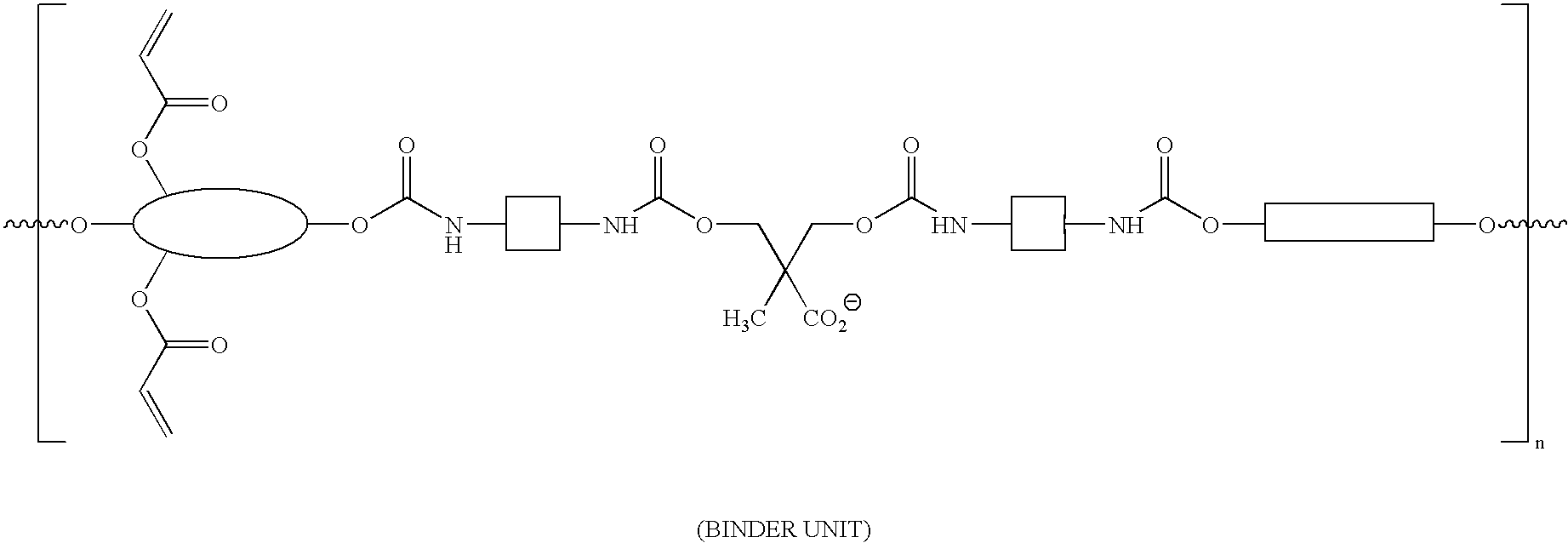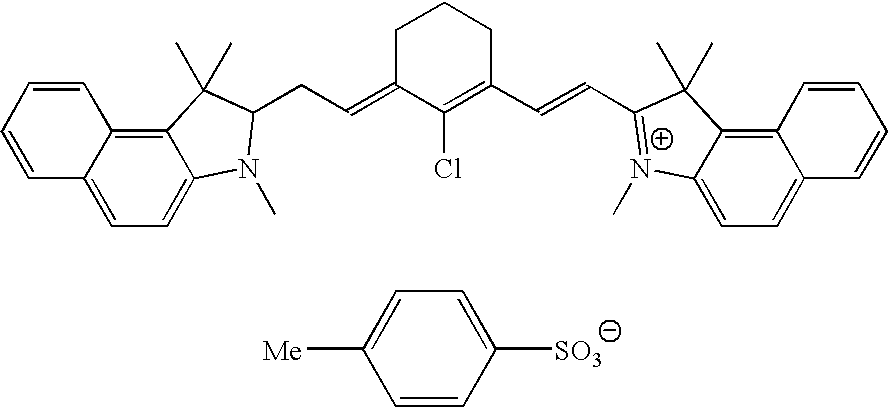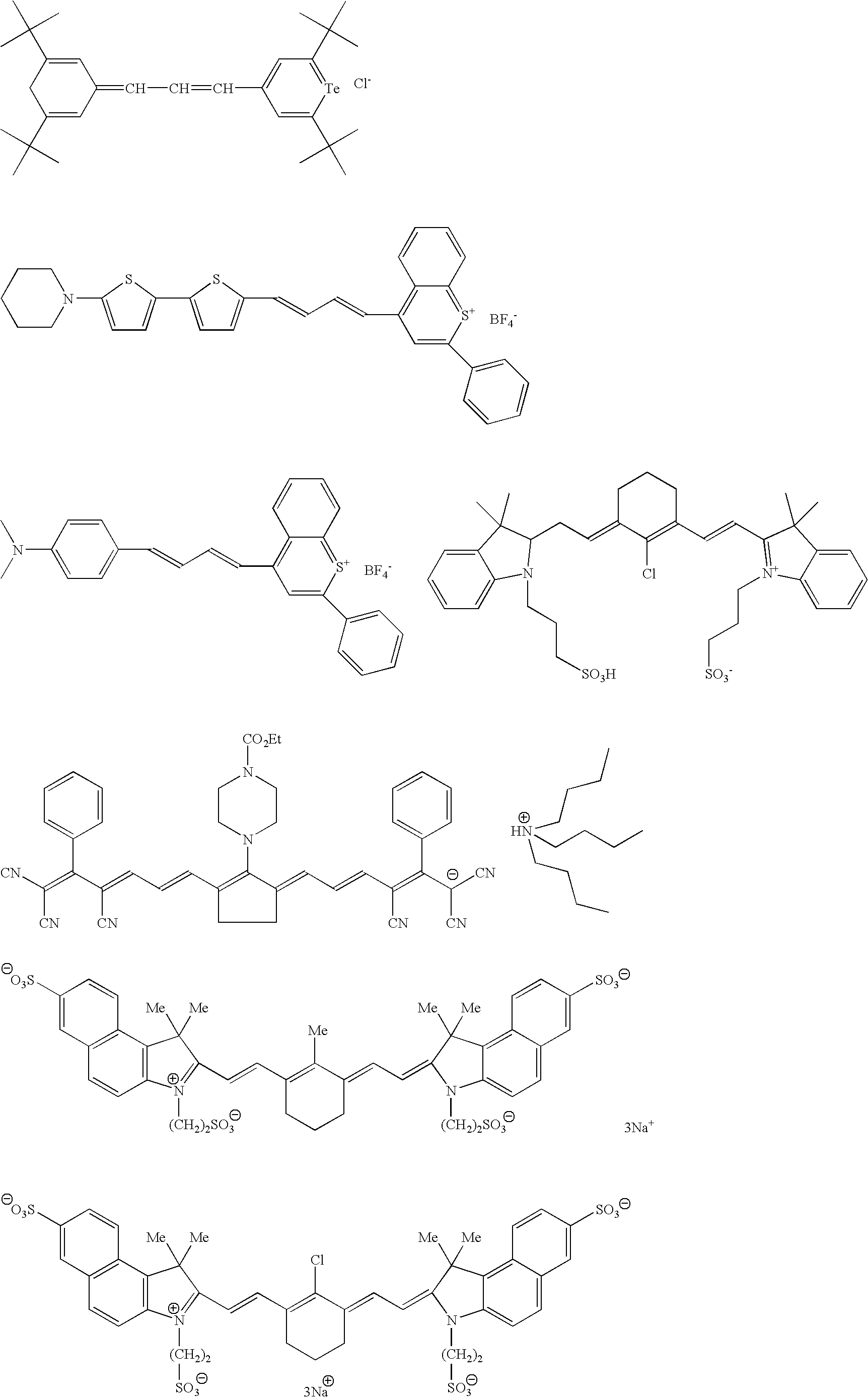Negative-working imageable elements and methods of use
- Summary
- Abstract
- Description
- Claims
- Application Information
AI Technical Summary
Benefits of technology
Problems solved by technology
Method used
Image
Examples
example 1
Negative-Working Imageable Element and Imaging Method—Two Layers
[0210]An imageable layer formulation was prepared by dissolving or dispersing 2.1 g of Bayhydrol® UV VPLS 2317 dispersion, 0.5 g of Sartomer 399, 0.5 g of NK ester A-DPH, 0.1 g of Phosmer PE, 0.2 g of IB-05, 0.07 g of IRT Dye, 0.3 g of Pigment A, and 0.02 g of Zonyl® FSN-100 in 1.5 g of BLO, 10 g of MEK, 2 g of methanol, and 0.5 g of water. The imageable layer formulation was applied to an electrochemically grained and sulfuric acid anodized aluminum substrate that had been post-treated with poly(vinyl phosphoric acid) to provide a dry coating weight of about 1.2 g / m2. On each resulting dried imageable layer, a topcoat formulation was applied, comprising 8 g of Elvanol® 5105, 92 g of water, and 0.04 g of Masurf® FS-1520 to provide a dry coating weight of about 0.8 g / m2. Both formulations were applied using a wire-wound rod and then dried for approximately 60 seconds in a Ranar conveyor oven set at 120° C.
[0211]The resul...
example 2
Negative-Working Imageable Element and Imaging Method—Two Layers
[0212]An imageable layer formulation was prepared by dissolving or dispersing 2.0 g of Bayhydrol® UV XP 2420 dispersion, 0.25 g of Sartomer 399, 0.25 g of NK ester A-DPH, 0.625 g of Oligomer 2 (80% in MEK), 0.1 g of Phosmer PE, 0.2 g of IB-05, 0.07 g of IRT Dye, 0.03 g of Crystal Violet, and 0.02 g of Zonyl® FSN-100 in 2.5 g of PGME, 1.5 g of BLO, 8 g of MEK, 2 g of methanol, and 0.5 g of water. The imageable layer formulation was applied to an electrochemically grained and sulfuric acid anodized aluminum substrate that had been post-treated with poly(vinyl phosphoric acid) to provide a dry coating weight of about 1.2 g / m2. On each resulting imageable layer, a topcoat formulation was applied, comprising 8 g of Elvanol® 5105, 92 g of water, and 0.04 g of Masurf® FS-1520 to provide a dry coating weight of about 0.8 g / m2. Both formulations were applied using a wire-wound rod and then dried for approximately 60 seconds in a...
example 3
Negative-Working Imageable Element and Imaging Method—Two Layers
[0214]An imageable layer formulation was prepared by dissolving or dispersing 2.1 g of Bayhydrol® UV VPLS 2280 dispersion, 0.25 g of Sartomer 399, 0.25 g of NK ester A-DPH, 0.625 g of Oligomer 2 (80% in MEK), 0.1 g of Phosmer PE, 0.2 g of IB-05, 0.07 g of IRT Dye, 0.03 g of Crystal Violet, and 0.02 g of Zonyl® FSN-100 in 2.5 g of PGME, 1.5 g of BLO, 8 g of MEK, 2 g of methanol, and 0.5 g of water. The imageable layer formulation was applied to an electrochemically grained and sulfuric acid anodized aluminum substrate that had been post-treated with poly(vinyl phosphoric acid) to provide a dry coating weight of about 1.2 g / m2. On each resulting imageable layer, a topcoat formulation was applied, comprising 8 g of Elvanol® 5105, 92 g of water, and 0.04 g of Masurf® FS-1520 to provide a dry coating weight of about 0.8 g / m2. Both formulations were applied using a wire-wound rod and then dried for approximately 60 seconds in...
PUM
 Login to View More
Login to View More Abstract
Description
Claims
Application Information
 Login to View More
Login to View More - R&D
- Intellectual Property
- Life Sciences
- Materials
- Tech Scout
- Unparalleled Data Quality
- Higher Quality Content
- 60% Fewer Hallucinations
Browse by: Latest US Patents, China's latest patents, Technical Efficacy Thesaurus, Application Domain, Technology Topic, Popular Technical Reports.
© 2025 PatSnap. All rights reserved.Legal|Privacy policy|Modern Slavery Act Transparency Statement|Sitemap|About US| Contact US: help@patsnap.com



